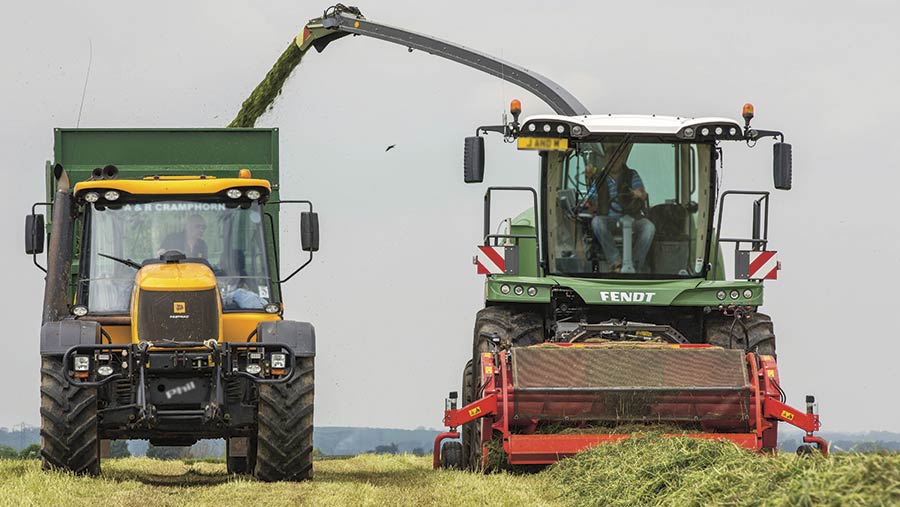First-cut grass silage – when is best for top quality?
There seems to be an unwritten rule that first cut grass silage is taken around 15 May when 50% of the sward is at the point of ear emergence.
This approach seems to be based on achieving a compromise between quality and quantity, with many arguing that cutting sooner will result in lower yields.
However, cutting later has a direct consequence on quality, says Roy Eastlake, Biotal national technical support manager.

© Tim Scrivener
See also: More on managing grazed grass
“Year in year out, standing grass in early May will have an energy content of around 12.5MJ and everyone will talk about the value of early season grass.
“Yet when clamps are analysed the average analysis of grass silages will be around 10.7MJ/kgDM. Somewhere a significant amount of energy is being lost.”
Mr Eastlake calculates that if the average silage quality could be increased by just 0.5MJ/kgDM and if cows were fed 10kgDM/day, the additional energy would be enough to produce an extra litre from forage a cow a day.
“At 26p, this would be an additional £52 milk income from forage a cow over a 200-day winter feeding period. Or it could save over £20 per cow in purchased feed costs.”
Cutting at the correct time
The starting point for high energy silage has to be cutting grass at the correct time. Once grass goes past the optimum growth stage, quality declines and energy is lost.
“D” value is a major determinant of energy content and is directly correlated to the ME level. Grass loses three units of “D” a week, particularly as the ear emerges.
“Delaying cutting until 50% is in head simply means that 50% of the grass has already gone over in terms of quality, so why not look to cut sooner? And this could be the ideal year to go early to boost first-cut quality.”
Mr Eastlake says that one of the impact of cows being kept out longer last autumn in an attempt to control production costs is that many units still have significant silage stocks. If, as appears likely, turnout is earlier than usual then winter silage requirements will also reduce, further increasing stocks.
“Higher stocks lead to two questions. The first is do we need to make as much first cut if we have plenty of feed already in the clamps? Second, 2016 was not a vintage silage season with generally lower feed value feeds produced, so why not focus on making higher quality first cut to better balance the stock when they are fed next winter?”
Objections to cutting early
He says that a proposal to cut earlier is usually met with two main objections. The first is that cutting earlier will reduce total production.
“Understandably, a forage strategy needs to balance quality with quantity. There is little point having wonderful quality if you will run out too soon. But, research shows that cutting early does not mean producing less in total across the season, and with increased stocks would it be a disaster if total yields are down if quality improves.”
Mr Eastlake says the second objection is that with contractors charging per acre, we need to maximise yield to get the best return on costs.
“My response would be is it worth making more of a poorer quality feed just to spread contractor charges by getting more quantity per acre? And cutting early can give a better return on contract charges (see table).”
Trial backs up earlier cutting
The table summarises a trial at SRUC which was set up to explore this particular issue. The difference between early and conventional cutting for first cut was 10 days and the better quality feed reflects the better D value.
While first-cut yields were reduced, quality was significantly improved. While the quality benefit also extended to second cut, the second-cut yields were also better, leading to a higher total tonnage and superior quality.
Overall this was worth an additional 1,400 litres production a hectare.
“Work out how much silage you need to feed a minimum 12kgDM/cow/day for next winter. Then subtract the stocks carried over and work out how much you actually need to produce.
“This year offers an ideal opportunity to move away from the fixation with mid-May and really focus on improving the quality of first cut as most farms have the safety net of higher stocks.”
A comparison of feed value from silage cut early and at a conventional time |
||||
|
Early cutting |
Conventional cutting |
|||
|
First cut |
Second cut |
First cut |
Second cut |
|
|
ME (MJ/kg DM) |
11.8 |
11.4 |
11.1 |
11.3 |
|
Yield (t DM/ha) |
4.2 |
4.1 |
5.5 |
2.5 |
|
Total yield (t DM/ha) |
8.3 |
8 |
||
|
Energy harvested (MJ) |
96,300 |
89,300 |
||
|
Milk yield potential |
18,519 |
17,173 |
||
|
Contracting costs/litre (assuming £131/ha charge) |
0.70p |
0.76p |
||
|
Adapted from: Thomas, Bax and Osman. 1998 |
||||
